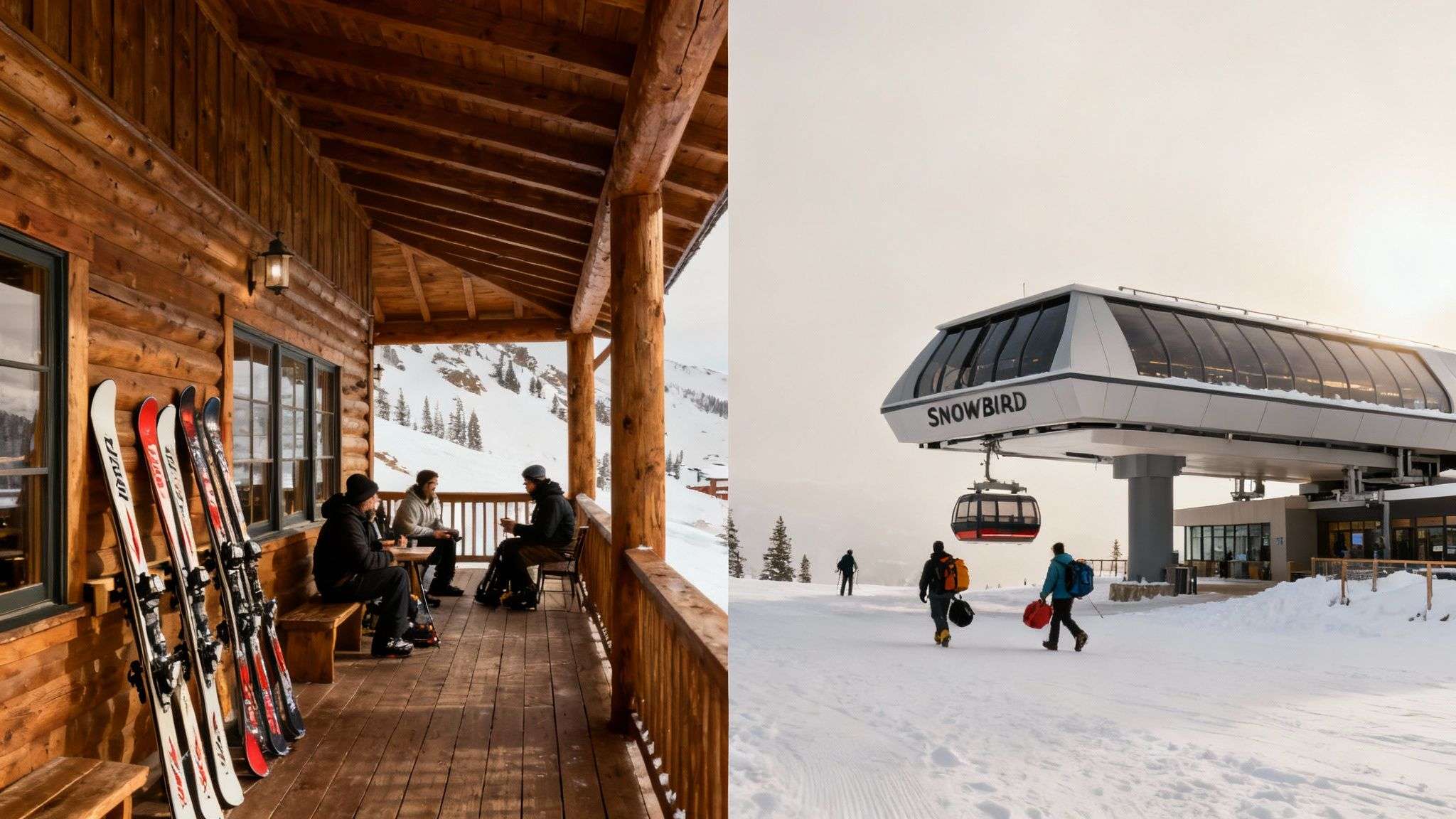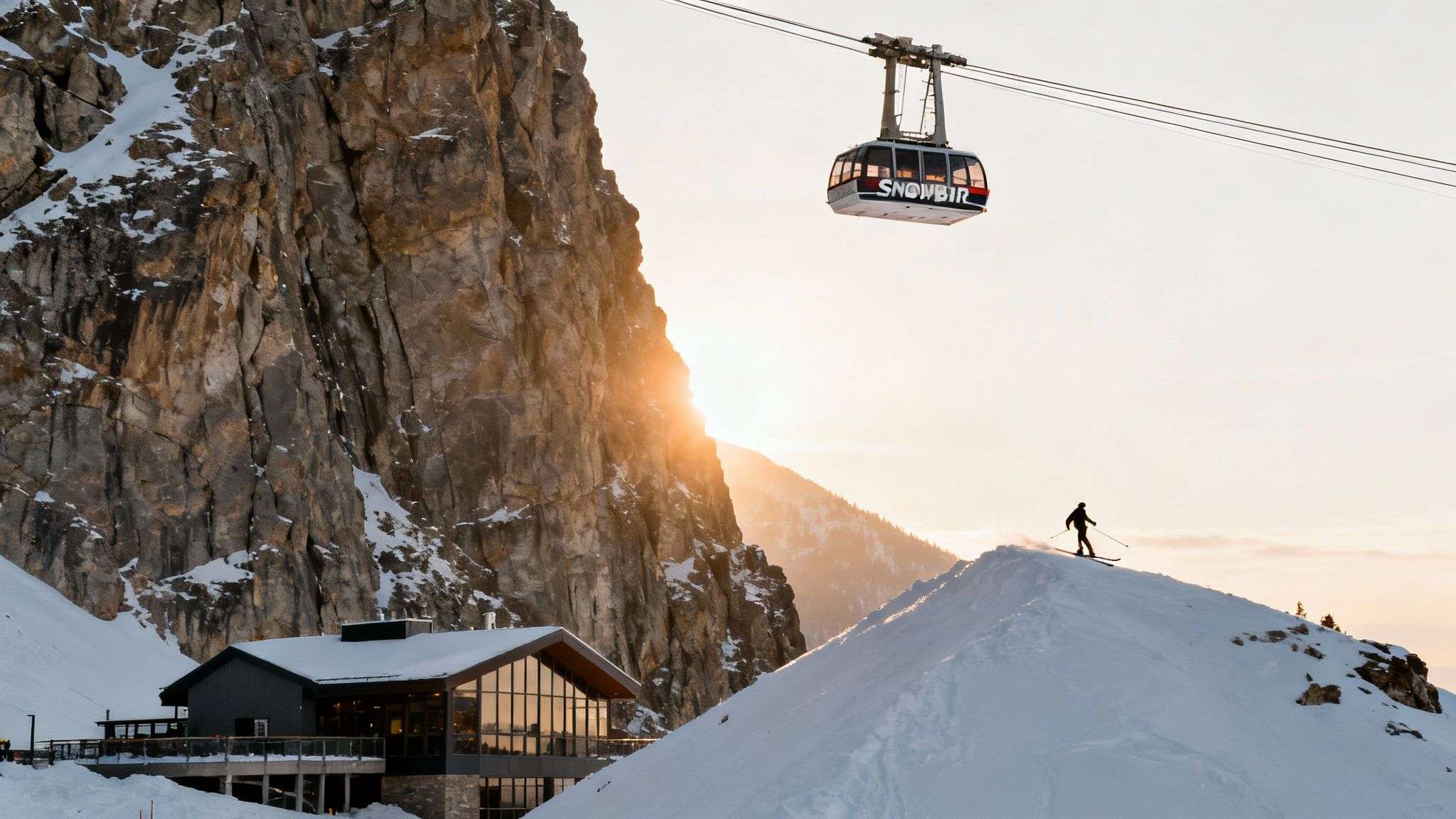Alta vs. Snowbird: Which Utah Ski Resort Should You Choose?
An expert guide comparing Alta and Snowbird. We break down the terrain, snow quality, vibe, and costs to help you decide which Little Cottonwood Canyon resort is right for you.
Deciding between Alta and Snowbird is the classic dilemma for skiers visiting Utah's Little Cottonwood Canyon. Alta is a timeless, skiers-only mountain celebrated for its legendary powder and traditional culture, while Snowbird is a modern, big-mountain playground with an iconic tram and terrain for both skiers and snowboarders. The right choice depends entirely on whether you're seeking a purist's powder paradise or a high-energy, full-service resort experience.

What's the Difference Between Alta and Snowbird?
Tucked deep in Utah's legendary Wasatch Mountains, Alta and Snowbird are literal next-door neighbors, sharing the same canyon road and the same blessing of "The Greatest Snow on Earth®." Both resorts get hammered with an average of over 500 inches of that famously light, dry powder every year. But that shared geography is where the similarities end. This guide goes beyond the basic stats to dig into what truly makes each resort unique, helping you figure out which mountain is the right fit for your skills and what you want out of a ski trip. Both are accessed via the scenic—and often challenging—drive up Little Cottonwood Canyon.
Alta vs. Snowbird at a Glance
To get started, here's a quick look at the core differences that define each resort. This table gives you a high-level feel for what to expect before we dive into the details.
| Feature | Alta | Snowbird |
|---|---|---|
| Who Can Ride | Skiers Only | Skiers & Snowboarders |
| Overall Vibe | Traditional, relaxed, community-focused | Energetic, modern, full-service resort |
| Defining Feature | Legendary powder and classic ski culture | Aerial Tram and steep, challenging terrain |
| Skiable Acres | 2,614 acres | 2,500 acres |
| Vertical Drop | 2,538 feet | 3,240 feet |
| Best For | Powder purists, traditionalists, families | Experts, adventurers, mixed groups |
Ultimately, the debate isn't about which resort is "better." It's about which one is better for you. Though they're just a stone's throw apart, Alta and Snowbird deliver two profoundly different days on the snow.
How Do Terrain and Snow Quality Compare?
Everyone knows the tagline: "The Greatest Snow on Earth®." In Little Cottonwood Canyon, it's less a marketing slogan and more a meteorological fact. But the way that legendary powder actually skis at Alta versus Snowbird tells the real story of two mountains with very different personalities, each shaped by its terrain, elevation, and aspect.

Snowfall and Preservation
Both resorts get absolutely hammered with snow. Alta clocks in with an average of 547 inches a year, while Snowbird isn't far behind, pulling in over 500 inches each season. Yet despite those similar mind-boggling numbers, Alta almost always wins the snow quality debate.
The reason is simple: aspect. Alta's terrain is almost entirely north-facing. This acts like a natural refrigerator, shielding the powder from the sun and keeping it light and dry for days after a storm. You can always get the latest conditions by checking our detailed Alta snow report, which includes live SNOTEL data.
Snowbird, on the other hand, is a bit more complicated. While its front-side Peruvian Gulch holds cold smoke incredibly well, the massive, sun-drenched Mineral Basin on the backside is a different beast entirely. As a result, conditions can swing from perfect powder to spring-like corn snow depending on the time of day and where you are on the mountain. You can get more great insight from in-depth resort comparisons about snow quality at Alta and Snowbird on PeakRankings.com.
Actionable Tip: If you're a purist chasing the absolute best powder, especially a few days after a storm, Alta’s north-facing terrain gives it the clear edge. Snowbird offers more variety, but you'll have to be strategic, chasing the sun or shade to find the best snow.
Terrain Character and Challenge
Beyond the snow itself, the mountains’ personalities are etched into their slopes. This isn't just a question of acreage; it's about the flow of the terrain and the kind of challenge it throws at you.
Alta's Classic Layout Alta just feels classic. It’s an old-school playground of rolling bowls, natural hits, and challenging traverses that force you to learn the mountain's secrets to unlock the best lines.
- Signature Runs: Everyone talks about High Rustler (or "High Boy"). It's that steep, iconic shot staring you down right from the base area.
- Powder Laps: The Supreme and Sugarloaf lifts open up a world of bowls and glades that are perfect for storm days. You can spend hours lapping this zone and still find fresh tracks.
- The Traverses: You have to earn your turns at Alta. Strong traversing skills are non-negotiable for accessing legendary zones like the Baldy Chutes, which adds a real element of adventure to your day.
Snowbird's Big-Mountain Feel Snowbird is all about raw power. It’s defined by its relentless, sustained vertical drop and intimidating terrain, all accessed directly from its legendary Aerial Tram.
- The Tram: One ride whisks you 2,900 vertical feet straight to Hidden Peak. From there, the mountain unfolds below you with steep chutes, massive open bowls, and groomers so long your legs will scream.
- Steep Chutes: Zones like The Cirque and Gad Chutes serve up some of the most challenging in-bounds terrain you can find anywhere in North America. These are serious, rocky lines that will test the best skiers and riders out there.
- Mineral Basin: On a bluebird day, this huge back bowl is pure bliss. It offers incredible views and wide-open cruising that provides a perfect contrast to the steep, technical terrain on the front side.
Ultimately, Alta is a mountain that encourages you to explore and find its hidden stashes. Snowbird simply dares you to conquer its immense vertical.
How Does the Vibe and Experience Differ?
Forget the stats for a minute. Beyond terrain maps and snow totals, a resort’s culture shapes every part of your day—from the conversations on the lift to the stories you tell over a beer. More often than not, the Alta vs. Snowbird debate boils down to the on-mountain vibe you’re after.

Alta: The Purist’s Sanctuary
The skiers-only policy is Alta's most defining feature, and it sets the tone for the entire mountain. The vibe is noticeably quieter and more traditional. It’s common to see skiers sharing beta on a tricky traverse or celebrating a great run together on the chairlift.
The base area reflects this same ethos. Instead of a sprawling village, you'll find classic, cozy lodges like the Alta Lodge and the Peruvian. These spots feel more like community gathering places than commercial hubs, fostering a friendly, low-key après scene where the main event is recounting the day's adventures.
Snowbird: The Modern Mountain Resort
Snowbird delivers a more energetic and comprehensive resort experience. The base area feels like a different world from Alta's, with large, modern facilities, a diverse array of restaurants, shops, and the luxurious Cliff Spa. A key part of Snowbird’s identity is its iconic aerial tram, which can whisk 125 people up the mountain at once.
This modern approach attracts a broader audience, including snowboarders and families looking for more than just skiing. The pace feels faster, and the amenities are geared toward a complete vacation. If you're planning a trip, check our guide on Snowbird ski resort conditions for real-time updates.
Local Tip: Alta feels like a private ski club where everyone shares a common passion. Snowbird feels like a world-class destination resort built for high adventure and convenience.
The Best of Both Worlds: The Alta-Bird Pass
For skiers who can’t decide—or simply want it all—the Alta-Bird pass is the answer. This upgrade lets you ski through gates connecting Snowbird's Mineral Basin with Alta's Sugarloaf area, effectively creating one massive 4,700-acre playground. This combined pass is the perfect choice for experts, explorers, or those on longer trips, but remember—it's for skiers only.
When Should You Choose Alta?
You choose Alta when the skiing itself is the whole point of your trip. If your perfect day is about chasing untracked lines with other people who are just as obsessed with snow as you are, then Alta is your place.
- The Powderhound: You live for light, dry powder. For you, Alta’s north-facing slopes aren’t just a feature; they’re essential. They hold that cold smoke for days after a storm, making every turn count.
- The Traditionalist: You’re looking for a mountain with history and a low-key, community vibe. You'd rather have a genuine conversation on a slow chairlift than navigate a bustling resort village.
- The Ski-Focused Family: Your main goal is to get your kids to fall in love with skiing. Alta's world-class ski school, quieter atmosphere, and straightforward base area make for a much less intimidating place to learn.
Alta is for the skier who doesn’t need a spa, a tram, or a dozen restaurants to have a perfect day. It’s for those who believe the ultimate luxury is 500 inches of the world's best snow, shared with people who feel the exact same way.

When Should You Choose Snowbird?
If Alta is for the ski purist, Snowbird is the clear answer for the modern adventurer who wants it all. It’s built for those who measure a trip by leg-burning vertical, a full menu of amenities, and the freedom to share the mountain with both skiers and snowboarders.
- The Expert Rider: You're here for the steepest lines and some of the most formidable terrain in North America. The 3,240 feet of sustained vertical drop served by the Aerial Tram is your playground.
- The Complete Vacationer: You want diverse dining, a post-shred soak at the Cliff Spa, and modern lodging. Snowbird’s well-developed base village delivers that full-service experience.
- The Mixed Group: Your crew has both skiers and snowboarders, making Alta a non-starter. In Little Cottonwood Canyon, Snowbird is the only choice that welcomes everyone to the party.
Snowbird is for the adventurer who measures a trip by vertical feet skied, challenges conquered, and memories made both on and off the mountain. It’s the ultimate destination for an all-encompassing, big-mountain adventure.
Alta vs. Snowbird FAQ
Which resort is better for beginners?
Both resorts have excellent learning areas, but many find Alta's relaxed vibe and legendary ski school less intimidating for first-timers. Snowbird's Chickadee lift is a perfect self-contained spot to get started, while Alta's Albion Basin is a wide-open, gentle playground ideal for building confidence.
How difficult is the drive up Little Cottonwood Canyon?
The road to Alta and Snowbird (SR-210) is steep and closes frequently for avalanche control during big storms. In winter, the law often requires a 4WD/AWD vehicle with proper snow tires. This affects both resorts equally, so being prepared is non-negotiable.
Local Tip: Always check the official UDOT Traffic website for real-time road status and traction law requirements before you even think about heading up the canyon.
Can I ski both resorts on the same ticket?
Yes, skiers can purchase an Alta-Bird ticket, which opens connecting gates between Snowbird's Mineral Basin and Alta's Sugarloaf area. It’s a fantastic way for strong intermediate and expert skiers to explore the massive combined 4,700 acres of terrain. Remember, this connection is strictly for skiers.
For live road conditions, traffic data, and cameras to plan your trip up the canyon, trust Wasatch Travel Helper. Get the full picture before you go at https://wasatchroads.com.